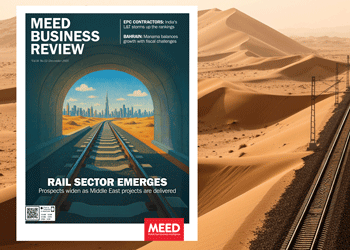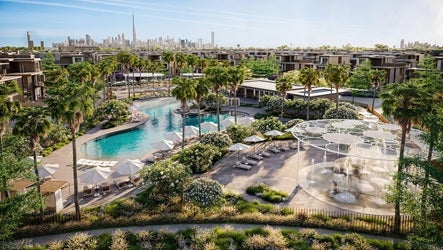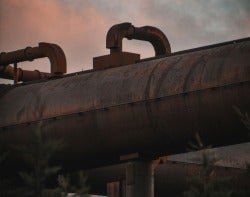Saudi Arabia under project pressure
28 March 2023

Saudi Arabia’s projects market is overheating. The volume of projects announced in the past six years vastly exceeds the resources that are available to work in the kingdom.
Combined with tight deadlines to complete projects as part of Vision 2030, the pressure on the construction industry to deliver is ratcheting up and turning the tables on the supply chain as the shift from a buyer’s to a seller’s market accelerates.
For the five years from 2016 to 2020, there was an average of about $14bn-worth of contract awards a year in Saudi Arabia for the construction and transport sectors. After rising to $21bn in 2021, the total rose to $32bn in 2022 – the second-best year on record.
The near doubling of the total annual value of contract awards by the end of 2022 has required a significant scale-up of resources in the kingdom, and the ramp-up is set to continue.
Much of this pressure is due to the five official gigaprojects, which are major programmes of work that will involve a sustained flow of contract awards for years to come.
Gigaproject focus
The project most recently classified as a gigaproject by the Saudi authorities is the Diriyah Gate development on the western outskirts of Riyadh. It joins the $500bn Neom development in the northwest of the kingdom, Qiddiya entertainment city outside Riyadh, Red Sea Global’s projects on the Red Sea coast and Roshn’s housing developments across the kingdom.
These projects are relatively new. They began to be launched in 2017 and spent much of the following three years in the design phase.
After a start that was hampered by the work and travel restrictions required to manage the Covid-19 pandemic, construction activity on these projects has accelerated sharply since the start of 2022.
According to regional project tracker MEED Projects, there have been $36bn-worth of contract awards across these official gigaprojects since 2017. Compared to the entire Saudi projects market over the same period that represents 14.5 per cent of contract awards.
The percentage rises to 20 per cent if a more recent time frame is used and only contract awards since the start of 2022 are included. As work gathers pace on the gigaprojects, their significance is expected to grow even further.
 More major projects
More major projects
Saudi Arabia’s ambitions are not limited to the five gigaprojects. In January, Crown Prince Mohammed bin Salman al-Saud launched the world’s largest modern downtown in Riyadh.
Known as the New Murabba project, it involves the development of 19 square kilometres of land to the northwest of the capital. The centrepiece of the project is the Mukaab, which is a 400-metre-cubed structure with a tower standing inside it.
New Murabba is part of a plan announced in January 2021 to double the size of Riyadh from 7.5 million residents to 15-20 million residents in 2030. Other major projects in the capital include King Salman International airport, King Salman Park, Sports Boulevard and Mohammed bin Salman Non-Profit City.
Beyond the capital there are development projects planned in all major urban centres by Saudi Downtown Company, as well as entertainment centres being developed by Saudi Entertainment Ventures (Seven).
Connecting these cities and projects will be railways, roads, ports and airports that form part of the National Transport & Logistics strategy, which aims to turn the kingdom into a global hub for travel and trade by 2030.
 World’s largest piling project shifts to The Line’s marina
World’s largest piling project shifts to The Line’s marina
Resourcing challenges
One of the key challenges for the development firms and government agencies responsible for delivering these projects is securing the resources they need.
As client bodies attempt to make their projects more attractive for companies to work on, the industry is changing. The first signs of this change can be seen in the consultancy market.
After years of searching for project opportunities, the big consultancy businesses are now only selectively bidding for projects in the kingdom. This is because their orderbooks are already full, and for many international firms there is a concern that they could become over-exposed to the Saudi market.
On contracts that have already been won there are also challenges. Staffing projects is proving difficult as the kingdom remains a hard sell for many project professionals, despite significant social reforms that have taken place in recent years.
Then, once staff have been recruited and deployed on projects, there is the prospect of losing them to competitors or clients that require the same human resources.
Securing contractors
As activity on site accelerates, the bigger concern is contracting resources. As things stand, there are not enough contractors working in Saudi Arabia to deliver all of the planned projects.
The first way to deal with this problem is to increase the capacity of contractors in the kingdom. In February this year, the Public Investment Fund (PIF) invested $1.3bn in four local construction firms: Al-Bawani Holding Company, Almabani General Contractors Company, El-Seif Engineering Contracting Company and Nesma & Partners Contracting Company.
This investment will allow the companies to scale up their capacity, adopt advanced technologies and improve local supply chains.
As these firms grow, the hope is that it will encourage other local companies to also expand.
International or regional companies can also help, and over the past two years foreign players have become active in the kingdom again. Firms such as Bouygues, Samsung C&T, Hyundai Engineering Construction, China State, Webuild, FCC, Alec, Consolidated Contractors Company and Urbacon Trading Contracting Company have all secured major orders.
In some cases, these contract awards have been supported with foreign finance, which gives the contractor an additional level of comfort when it comes to potential payment for projects. For others, the contract awards reflect growing assurance in the Saudi market.
Boosting appeal
Confidence has been lifted by measures to make the Saudi market more attractive. Payment terms are improving and many of the frustrations typically faced by contractors are being addressed.
One example is the use of performance guarantees. Red Sea Global, which is developing the Red Sea Project and Amaala gigaprojects on the Red Sea coast, no longer requires contractors to submit bid bonds and returns performance bonds on completion of the project, along with half of the retention.
Alternative procurement methods and contract types are also being used, notably early contractor involvement and design and build.
These different approaches reduce risk for the contractor and allow the client to lock in resources at a much earlier stage of the procurement process.
Red Sea Global has adopted a different approach and is self-delivering the bulk of its projects. By acting as its own management contractor, it engages with subcontractors itself. While this means it does not need to secure the services of a main contractor, it still requires engaging with the supply chain, which – like the main contractor market – has finite resources in Saudi Arabia.
Payment terms are improving and many of the frustrations typically faced by contractors are being addressed
Driving efficiency
On the other side of the equation, making construction more efficient could also help to limit the resources required.
Client bodies are exploring modern methods of construction to increase the speed of delivery, reduce costs and cut the amount of resources needed on site.
The market could also be self-limiting. Decision-making in the kingdom remains centralised, which means key project decisions can be slow. While this is changing as development companies are left to run their own projects, bureaucracy can impact the speed of delivery, which ultimately reduces the immediate demand for resources on a project.
While slow decision-making could impact progress on some projects, the overriding story for 2023 will be one of sustained pressure on the kingdom’s construction sector as it becomes a seller’s market.
With that, there is the likelihood that contractor margins will start to creep up, just as they did in the UAE when its construction market overheated in 2003 and 2008.
So far, that does not appear to have happened, as clients in Saudi Arabia have managed to find sufficient resources. For that to remain the case will be a major challenge, however, as on-site activity for most projects in the kingdom is still several years away from peaking.
|
International contractors continue to see a level of risk in the Saudi market “There is a lot of opportunity. A large volume of work is being planned, designed and rolled out. With that, there is significant pressure right now on the market in terms of resources and supply chain. “On the consultancy side, the market is tremendously difficult. “Even with the best incentives and best set of practices, retaining staff is a challenge. People are being attracted elsewhere and the competition is fierce. “For the contractors, there are a lot of tenders being let. The perception that the market has risk remains, however. That is certainly the perception for international contractors, and they are still looking at the Saudi market with some level of risk appreciation in terms of how quickly they are going to be paid and what the margins really are. “That approach will likely prevail for the short to medium term, until clients’ practices change in terms of contractual frameworks and payment practices. “Varied procurement practices are coming into play to guarantee supply chain. It might be early contractor involvement or partnering, but the main purpose is to guarantee the right level of contractors.” |
|
To prevent resource shortages, supply chain and procurement must be carefully considered “It is imperative to consider alternative methods of procurement during boom times, and the current boom in Saudi Arabia is unprecedented considering the types, size, nature and complexity of projects that have been announced in line with Vision 2030. “This necessitates giving due consideration to the supply chain and type of procurement. “It is not enough to look for resources locally or even regionally to cope with such projects. One needs to reach out to where such resources are available globally, either due to slowdowns in certain regions or the completion of other major projects. “Cost-plus contracts were used previously in many projects in Saudi Arabia. However, the risk for such contracts rests with the client and sometimes the cost ends up much more than expected. That is why financiers prefer the lump-sum type of contracts. “Nonetheless, I can see this type of contract being used for fast-track projects with very tight schedules, for instance to meet deadlines for facilities required for international or regional sporting events. “In any case, the evaluation and selection of contractors needs to be done with extreme diligence.” |
MEED's April 2023 special report on Saudi Arabia includes:
> ECONOMY: Riyadh steps up the Vision 2030 tempo
> CONSTRUCTION: Saudi construction project ramp-up accelerates
> UPSTREAM: Aramco slated to escalate upstream spending
> DOWNSTREAM: Petchems ambitions define Saudi downstream
> POWER: Saudi Arabia reinvigorates power sector
> WATER: Saudi water begins next growth phase
> BANKING: Saudi banks bid to keep ahead of the pack
Exclusive from Meed
-
 Regional rail industry emerges
Regional rail industry emerges8 December 2025
-
 Aldar and Mubadala plan $16bn financial district expansion
Aldar and Mubadala plan $16bn financial district expansion8 December 2025
-
 Visa agrees to support digital payments in Syria
Visa agrees to support digital payments in Syria5 December 2025
-
 Meraas announces next phase of Nad Al-Sheba Gardens
Meraas announces next phase of Nad Al-Sheba Gardens5 December 2025
-
 Frontrunner emerges for Riyadh-Qassim IWTP
Frontrunner emerges for Riyadh-Qassim IWTP5 December 2025
All of this is only 1% of what MEED.com has to offer
Subscribe now and unlock all the 153,671 articles on MEED.com
- All the latest news, data, and market intelligence across MENA at your fingerprints
- First-hand updates and inside information on projects, clients and competitors that matter to you
- 20 years' archive of information, data, and news for you to access at your convenience
- Strategize to succeed and minimise risks with timely analysis of current and future market trends

Related Articles
-
 Regional rail industry emerges
Regional rail industry emerges8 December 2025
 Commentary
Commentary
Colin Foreman
EditorRead the December issue of MEED Business Review
The GCC is experiencing a fundamental shift in its approach to rail infrastructure, as it moves from standalone projects to a self-sustaining regional industry. The transition is evident as local, national and regional projects advance across the region.
The first wave of metro systems, in Dubai, Doha, and most recently, Riyadh, have reported stronger-than-expected ridership and demonstrated the viability of mass transit in the Gulf.
Extensions to those networks are planned or under way, including Dubai’s Blue and Gold lines and Riyadh’s Line 2, alongside planned metros elsewhere such as Muscat and Bahrain.
Projects are also planned and already being delivered at the national level. The UAE’s Etihad Rail and Saudi Arabian Railways are leading most of these efforts. The region’s first cross-border project is also progressing with the Hafeet Rail scheme linking the UAE and Oman.
Other cross-border schemes are planned, including high speed links connecting Riyadh with Doha and Kuwait City, and rail links for Bahrain across causeways to Saudi Arabia and Qatar. The ultimate ambition is a GCC Rail network – a project that was reinvigorated by the Al-Ula accords in 2021.
Sustained, simultaneous activity across the GCC is fostering the development of an indigenous regional rail industry. Rather than being executed as isolated endeavours, projects are creating ongoing demand for expertise, personnel and resources within the region.
Project delivery capability will be complemented by the establishment of crucial ancillary services, including fabrication and servicing facilities.
These operations will shift the GCC from a lucrative market for international contractors to a regional hub for the rail industry, capable of servicing and sustaining its growing network.
 READ THE DECEMBER 2025 MEED BUSINESS REVIEW – click here to view PDF
READ THE DECEMBER 2025 MEED BUSINESS REVIEW – click here to view PDFProspects widen as Middle East rail projects are delivered; India’s L&T storms up MEED’s EPC contractor ranking; Manama balances growth with fiscal challenges
Distributed to senior decision-makers in the region and around the world, the December 2025 edition of MEED Business Review includes:
> AGENDA 1: Regional rail construction surges ahead> INDUSTRY REPORT 1: Larsen & Toubro climbs EPC contractor ranking> INDUSTRY REPORT 2: Chinese firms expand oil and gas presence> CONSTRUCTION: Aramco Stadium races towards completion> RENEWABLES: UAE moves ahead with $6bn solar and storage project> INTERVIEW: Engie pivots towards renewables projects> BAHRAIN MARKET FOCUS: Manama pursues reform amid strainTo see previous issues of MEED Business Review, please click herehttps://image.digitalinsightresearch.in/uploads/NewsArticle/15213797/main.gif -
 Aldar and Mubadala plan $16bn financial district expansion
Aldar and Mubadala plan $16bn financial district expansion8 December 2025
Register for MEED’s 14-day trial access
Abu Dhabi's sovereign wealth fund, Mubadala Investment Company, and local developer Aldar have established a joint venture to deliver an expansion of the financial district on Al-Maryah Island with a gross development value of AED60bn-plus ($16bn-plus).
The development will be built on the undeveloped land bank on the north side of Al-Maryah Island, covering about 500,000 square metres (sq m), and will support the next phase of growth for Abu Dhabi Global Market (ADGM).
The masterplan encompasses 1.5 million sq m of new office, residential, retail and hospitality floor space.
In an official statement, the firms said that the core objective of the project is to support the continued expansion of ADGM, Abu Dhabi’s international financial centre. ADGM now has more than 11,000 active licences registered in the free zone and is among the fastest-growing financial hubs globally.
"Nearly 40,000 people are already based within the district, and demand for space remains strong," the statement added.
The Al-Maryah Island expansion will add over 450,000 sq m of Grade A office space, doubling the island’s current office inventory.
The expansion will add over 3,000 residences on the waterfront.
The next phase will also add a further 40,000 sq m of retail and dining spaces.
A central feature of the expansion is the Al-Maryah Waterfront enhancement project. This will include a bay fountain capable of water displays up to 75 metres high, forming the focal point of a reconfigured waterfront with additional dining, leisure and event spaces designed to complement existing assets on the island.
Three new bridges are proposed to link the north side of Al-Maryah Island with Reem Island and the Abu Dhabi mainland, reducing travel time to Saadiyat Island to under 10 minutes.
The enabling works on these projects are due to begin in 2026.
The new joint venture is owned 60% by Aldar and 40% by Mubadala.
"The two organisations are close to completing the legal work on a retail joint venture that will own and operate several of Abu Dhabi’s leading retail destinations, including The Galleria Al-Maryah Island, Yas Mall and the planned Saadiyat Grove Mall," the statement added.
 READ THE DECEMBER 2025 MEED BUSINESS REVIEW – click here to view PDF
READ THE DECEMBER 2025 MEED BUSINESS REVIEW – click here to view PDFProspects widen as Middle East rail projects are delivered; India’s L&T storms up MEED’s EPC contractor ranking; Manama balances growth with fiscal challenges
Distributed to senior decision-makers in the region and around the world, the December 2025 edition of MEED Business Review includes:
> AGENDA 1: Regional rail construction surges ahead> INDUSTRY REPORT 1: Larsen & Toubro climbs EPC contractor ranking> INDUSTRY REPORT 2: Chinese firms expand oil and gas presence> CONSTRUCTION: Aramco Stadium races towards completion> RENEWABLES: UAE moves ahead with $6bn solar and storage project> INTERVIEW: Engie pivots towards renewables projects> BAHRAIN MARKET FOCUS: Manama pursues reform amid strainTo see previous issues of MEED Business Review, please click herehttps://image.digitalinsightresearch.in/uploads/NewsArticle/15213568/main.jpg -
 Visa agrees to support digital payments in Syria
Visa agrees to support digital payments in Syria5 December 2025
Visa and the Central Bank of Syria have agreed on a strategic roadmap that will allow the US-based card and digital payments company to begin operations in Syria and support the development of a modern digital payments system.
Under the agreement, Visa will work with licensed Syrian financial institutions under a phased plan to establish a secure foundation for digital payments.
The early stages will involve Visa supporting the central bank in issuing Europay, Mastercard and Visa (EMV)-compliant payment cards and enabling tokenised digital wallets – bringing the country in line with internationally interoperable standards.
Visa will also provide access to its platforms, including near-field communication (NFC) and QR-based payments, invest in local capacity building and support local entrepreneurs seeking to develop solutions leveraging Visa’s global platform.
“A reliable and transparent payment system is the bedrock of economic recovery and a catalyst that builds the confidence required for broader investment to flow into the country,” noted Visa’s senior VP for the Levant, Leila Serhan. “This partnership is about choosing a path where Syria can leapfrog decades of legacy infrastructure development and immediately adopt the secure, open platforms that power modern commerce.”
The move marks one of the most significant steps yet in Syria’s slow and uneven return to the formal global financial system and carries implications that reach beyond just payments technology.
It lays the groundwork for overturning more than a decade of financial isolation in which Syria has operated largely outside global banking and settlement networks.
Visa’s entry will not erase all existing barriers – as many restrictions remain in force and will continue to shape what is practically possible – but its support signals a reopening of channels that could smooth Syria’s reintegration into financial networks.
The involvement of the US-based payments provider is also a further tacit sign of the US government’s enthusiastic bear hug of the new post-Assad Syrian government under President Ahmed Al-Sharaa.
For investors assessing long-term opportunities, the presence of a globally recognised payments operator will provide reassurance that Syria’s financial system is returning to international norms, and the security and transparency that comes with it.
https://image.digitalinsightresearch.in/uploads/NewsArticle/15207198/main3225.gif -
 Meraas announces next phase of Nad Al-Sheba Gardens
Meraas announces next phase of Nad Al-Sheba Gardens5 December 2025
Dubai-based real estate developer Meraas Holding, which is part of Dubai Holding, has announced the eleventh and final phase of its Nad Al-Sheba Gardens residential community in Dubai.
It includes the development of 210 new villas and townhouses and a school, which will be located at the northwest corner of the development.
The latest announcement follows Meraas awarding a AED690m ($188m) contract for the construction of the fourth phase of the Nad Al-Sheba Gardens community in May, as MEED reported.
The contract was awarded to local firm Bhatia General Contracting.
The scope of the contract covers the construction of 92 townhouses, 96 villas and two pool houses.
The contract award came after Dubai-based investment company Shamal Holding awarded an estimated AED80m ($21m) contract to UK-based McLaren Construction last year for the Nad Al-Sheba Gardens mall.
The project covers the construction and interior fit-out of a two-storey mall, covering an area of approximately 12,600 square metres.
The UAE’s heightened real estate activity is in line with UK analytics firm GlobalData’s forecast that the construction industry in the country will register annual growth of 3.9% in 2025-27, supported by investments in infrastructure, renewable energy, oil and gas, housing, industrial and tourism projects.
The residential construction sector is expected to record an annual average growth rate of 2.7% in 2025-28, supported by private investments in the residential housing sector, along with government initiatives to meet rising housing demand.
https://image.digitalinsightresearch.in/uploads/NewsArticle/15206904/main.jpg -
 Frontrunner emerges for Riyadh-Qassim IWTP
Frontrunner emerges for Riyadh-Qassim IWTP5 December 2025

Saudi Arabia’s Vision Invest has emerged as frontrunner for the contract to develop the Riyadh-Qassim independent water transmission pipeline (IWTP) project, according to sources.
State water offtaker Saudi Water Partnership Company (SWPC) is preparing to award the contract for the IWTP "in the coming weeks", the sources told MEED.
The project, valued at about $2bn, will have a transmission capacity of 685,000 cubic metres a day. It will include a pipeline length of 859 kilometres (km) and a total storage capacity of 1.59 million cubic metres.
In September, MEED reported that bids had been submitted by two consortiums and one individual company.
The first consortium comprises Saudi firms Al-Jomaih Energy & Water, Al-Khorayef Water & Power Technologies, AlBawani Capital and Buhur for Investment Company.
The second consortium comprises Bahrain/Saudi Arabia-based Lamar Holding, the UAE's Etihad Water & Electricity (Ewec) and China’s Shaanxi Construction Installation Group.
The third bid was submitted by Saudi Arabia's Vision Invest.
It is understood that financial and technical bids have now been opened and Vision Invest is likely to be awarded the deal.
The Riyadh-based investment and development company made a "very aggressive" offer, one source told MEED.
In November, the firm announced it had sold a 10% stake in Saudi Arabia-based Miahona as part of a strategy to reallocate capital "towards new and diversified investments".
The company did not disclose which projects the capital might be reallocated towards.
As MEED recently reported, Vision Invest is also bidding for two major packages under Dubai's $22bn tunnels programme in a consortium with France's Suez Water Company.
The Riyadh-Qassim transmission project is the third IWTP contract to be tendered by SWPC since 2022.
The first two are the 150km Rayis-Rabigh IWTP, which is under construction, and the 603km Jubail-Buraydah IWTP, the contract for which was awarded to a team of Riyadh-based companies comprising Al-Jomaih Energy & Water, Nesma Group and Buhur for Investment Company.
Like the first two IWTPs, the Riyadh-Qassim IWTP project will be developed using a 35-year build-own-operate-transfer contracting model.
Commercial operations are expected to commence in the first quarter of 2030.
https://image.digitalinsightresearch.in/uploads/NewsArticle/15206609/main.jpg


 Daniel King, director, Currie & Brown
Daniel King, director, Currie & Brown Adel Karem Jemah, senior vice-president, Hill International
Adel Karem Jemah, senior vice-president, Hill International
